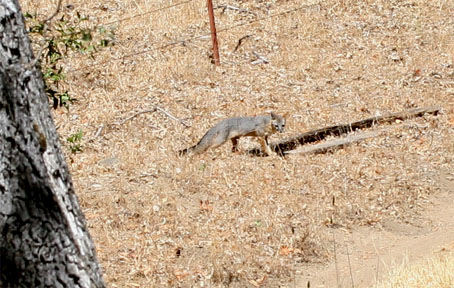
Feeding: Omnivorous. It is classed as a carnivore based on its tooth structure, and it eats rabbits, mice, gophers, woodrats, and squirrels are the principal foods. However, this carnivore also eats large amounts of fruits, nuts, grains, grasshoppers and crickets, beetles, moths and butterflies, carrion, and small amounts of herbage. One fox examined in Yosemite had what looked like oak mast (acorns) in its stomach. Stalks and pounces on rodents and rabbits, or may pursue for short distances. Readily climbs into crooked trees, or those with branches 3 m (10 ft), or less, from the ground.
Cover: Brush, natural cavities, and occasionally human-made structures, provide cover.
Reproduction: Dens in natural cavities, in rocky areas, snags, logs, brush, slash and debris piles, abandoned burrows, and under buildings. Nest material usually dry grass, leaves, or shredded bark.
Water: Requires a permanent water source near den; probably drinks daily.
Pattern: Suitable habitat consists of shrublands, brushy and open-canopied forests, interspersed with riparian areas, providing water.
Activity Patterns: Active all year. Primarily crepuscular and nocturnal, occasionally active in daytime. The fox moves usually with a brisk trot which covers a lot of territory but seems to take little effort. This allows it to cover a lot of foraging territory, looking and listening for prey or finding new sources of vegetative food.
Seasonal Movements / Migration: Non-migratory.
Home Range: In Wisconsin, home ranges varied from 0.13 to 3.1 km? (0.05 to 1.2 mi?). In Florida, home ranges averaged 7.7 km? (8 mi?), and in Utah, home ranges averaged 1.0 km? (0.4 mi?) (Trapp and Hallberg 1975). Near Davis, California, Fuller (1978) found that 4 females had an average home range of 1.2 km? (0.5 mi?). The National Trappers Association website states that they tend to keep to a small territory, usually a square mile in size, and cover the territory well.
Territory: Family groups (parents with juveniles) usually are separated spatially, indicating territoriality.
Reproduction: Mates February through March. In California, most births occur in April, following a gestation of approximately 63 days. Average litter size is 4 pups; range 2-7. One litter/yr. Males and females are sexually mature at 1 yr.
Niche: Adult gray foxes have few predators. Large hawks, golden eagles, great horned owls, domestic dogs, and bobcats may prey on pups. May carry tularemia and rabies. Population levels may be affected by rabies.
![]()
This grey fox was seen near the cabin. It walked up from the road near the dump, crossed over to the tubs, and jumped up on the rim of the tub with grace and control. After taking a few drinks, it trotted along the road toward the gate, in the direction of North Flat. It heard something to the left, listened for a bit, and hearing nothing, started to leave. In a few steps it heard something again, so it circled around to the high side of the sound.

This photo was taken in San Francisco.
The material in this page was gathered primarily from the two sources below and from personal observation.